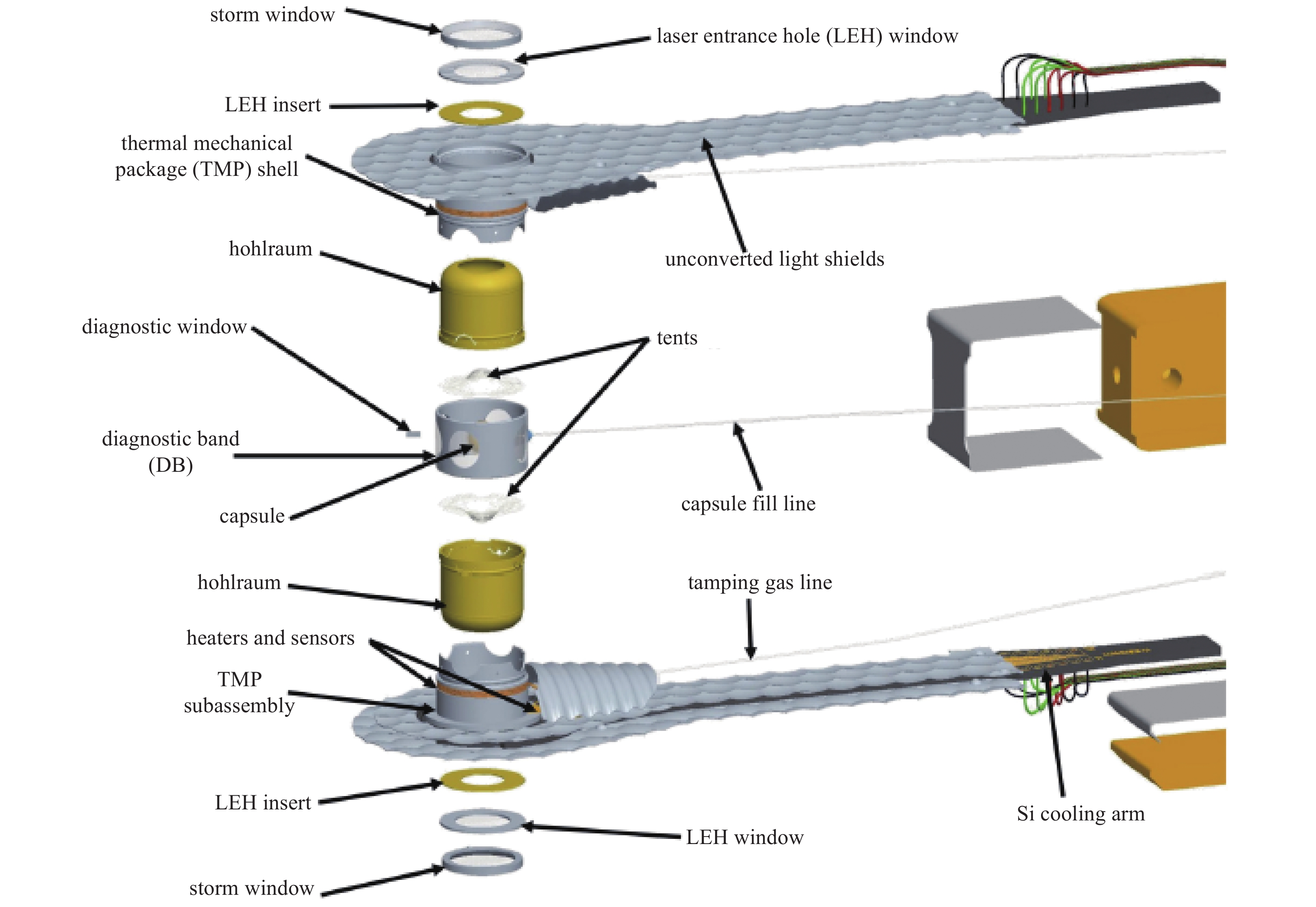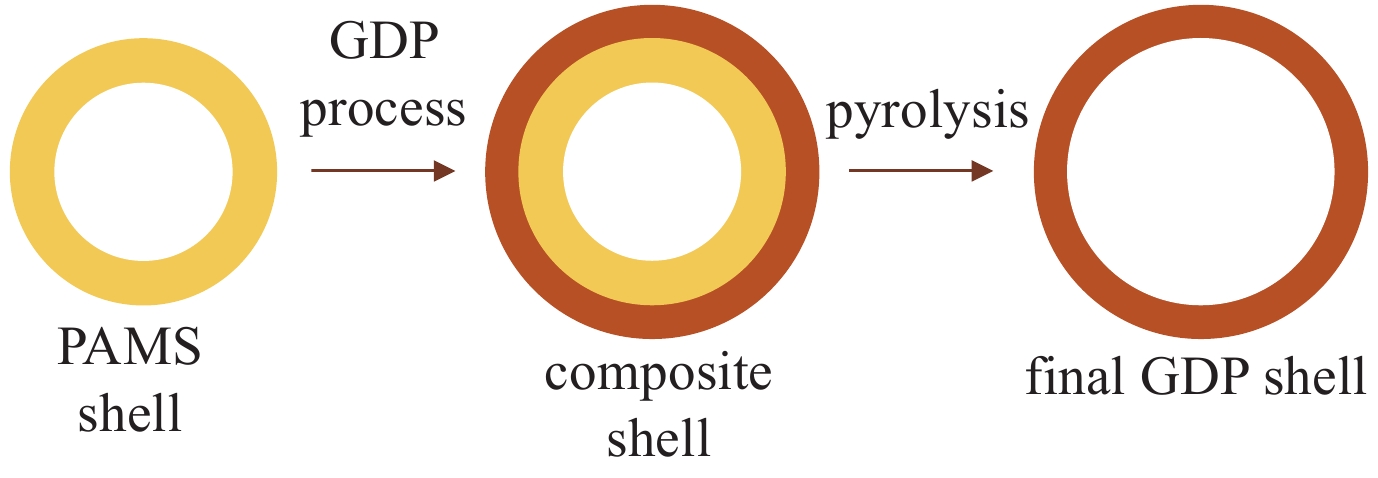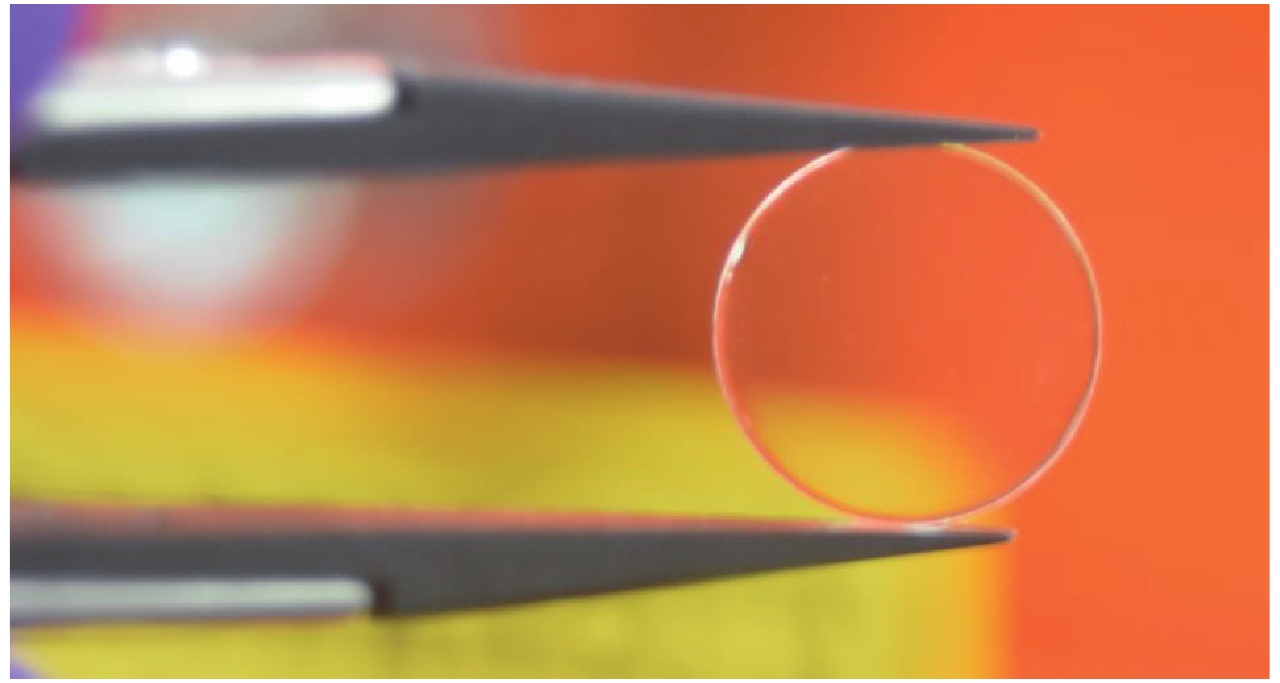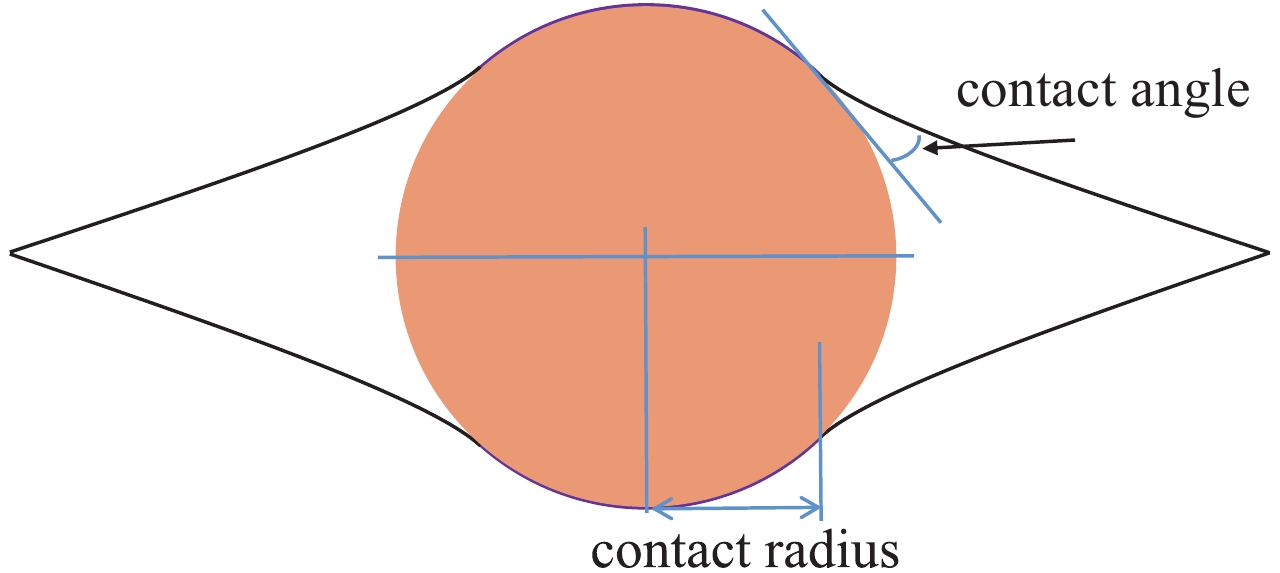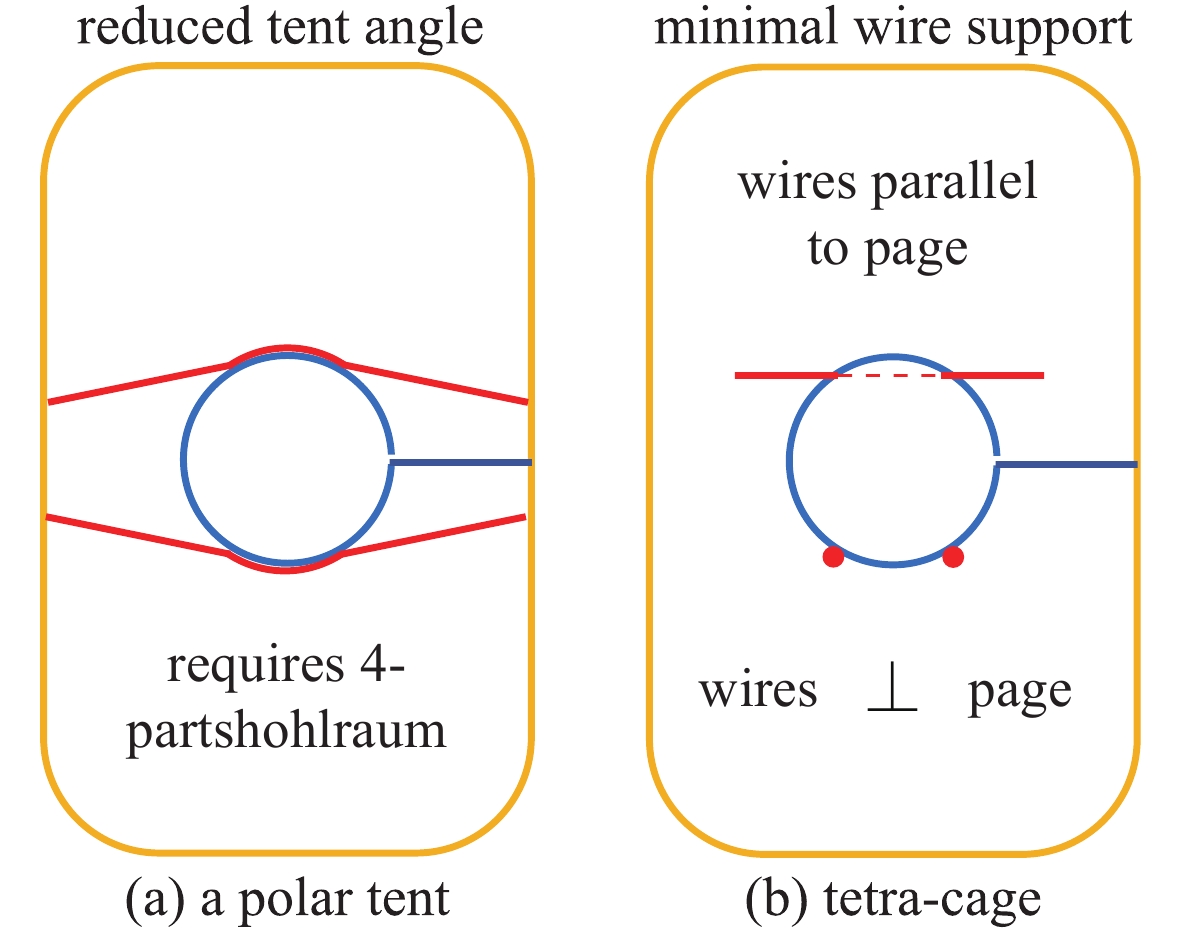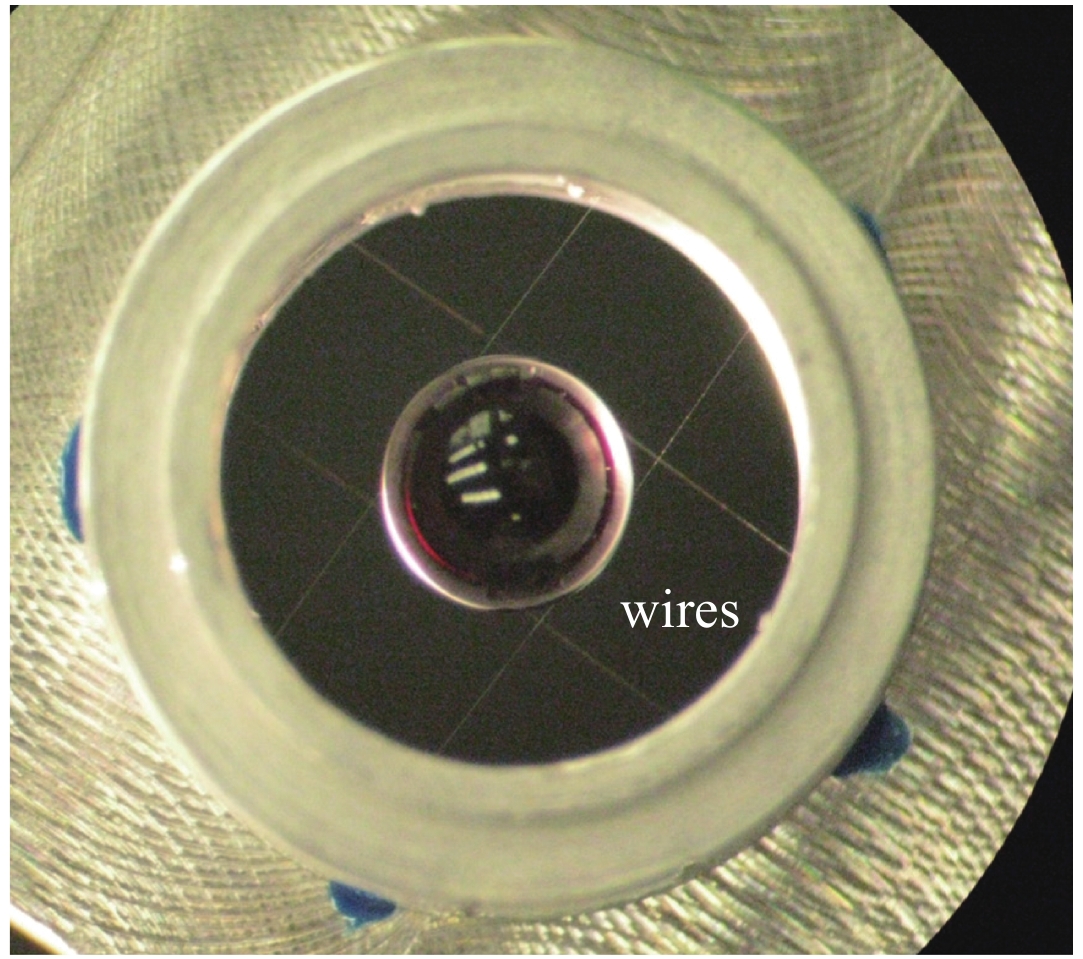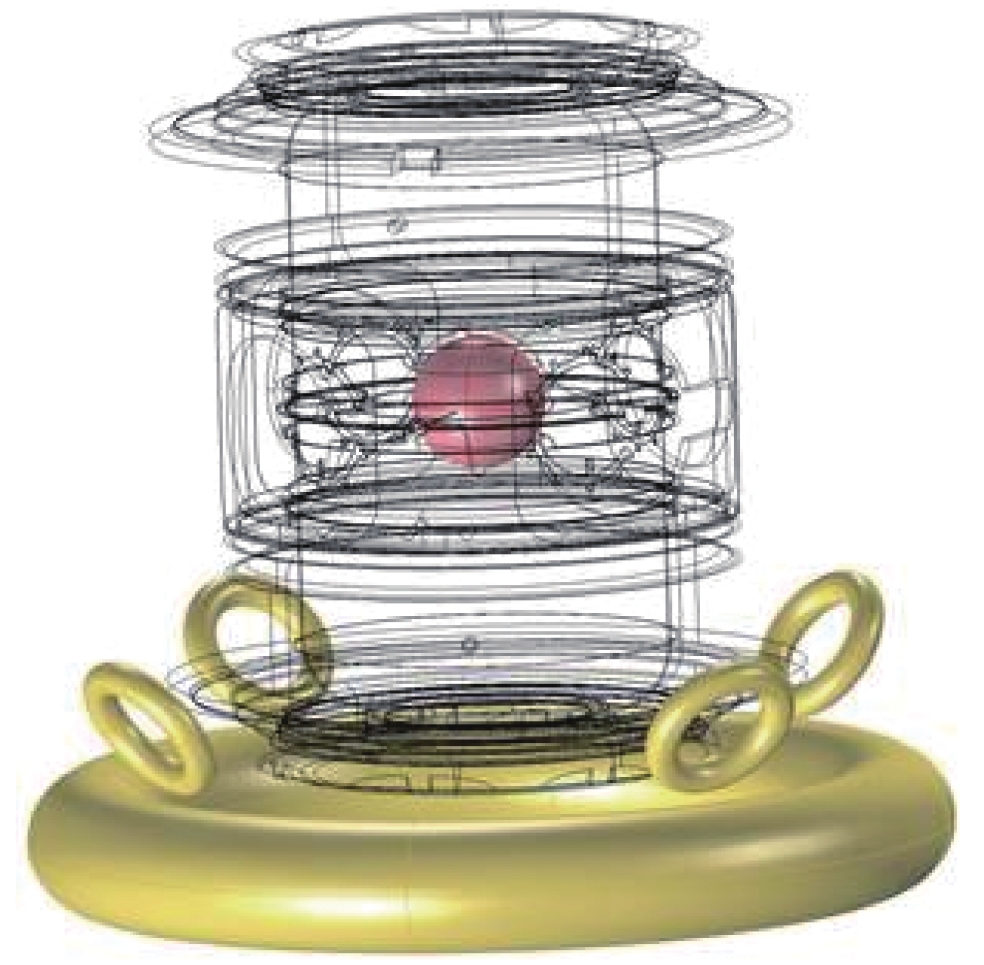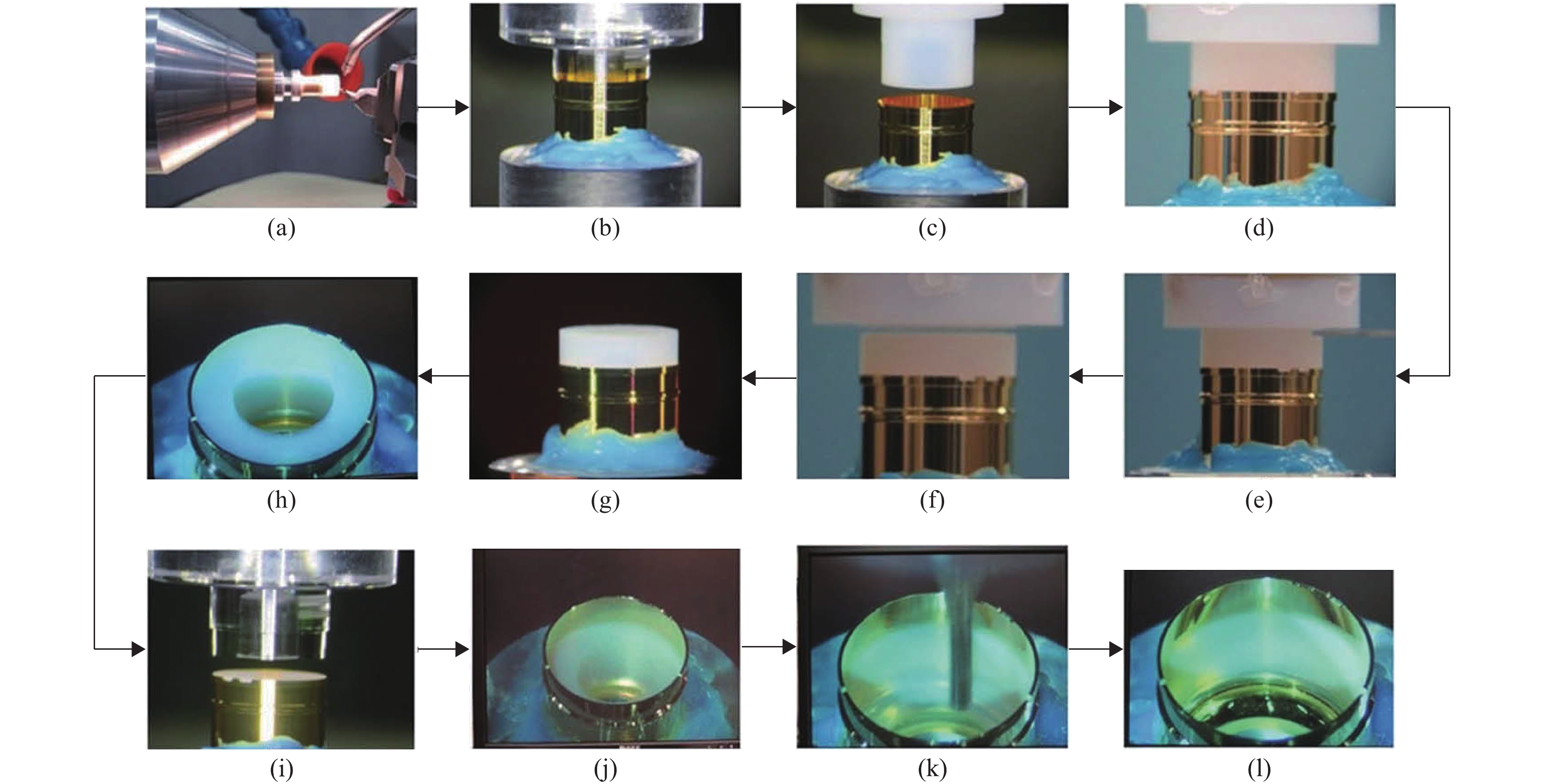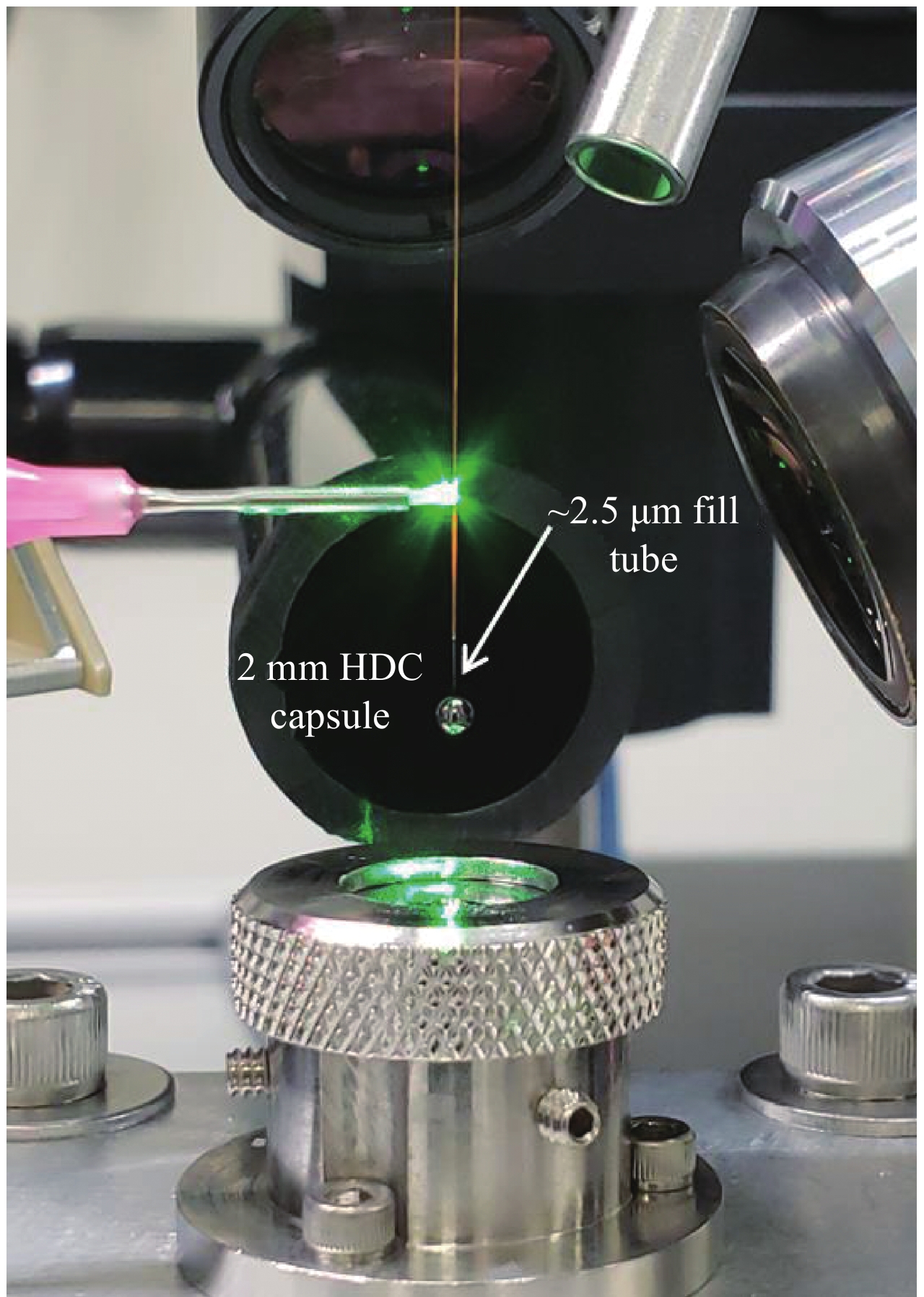Research progress of fabrication techniques for laser inertial confinement fusion target
-
摘要: 在实验室实现聚变反应释放的能量大于点燃聚变反应所需能量的阈值是当今世界ICF研究的主要目标,实现这一目标仍需要深入研究一系列的关键物理问题。在ICF研究中,制靶能力的发展与提升至关重要,靶的质量是实验成功的核心要素之一。本文介绍了国际ICF靶制备工作近年来在新型烧蚀层材料靶丸、新型靶丸支撑技术、优化黑腔材料与构型以及减小燃料填充管直径等方面取得的一系列进展,并结合ICF物理需求,简要阐述了ICF靶的发展趋势。Abstract: The main goal of inertial confinement fusion (ICF) research is to realize that the energy released by fusion reaction is greater than the threshold value of ignition fusion reaction in the laboratory. A series of key physical problems must be explored deeply for the purpose. In ICF, the capability of target fabrication is particularly important, and the quality of target is the pivotal element of physical experiment. This paper expounds the progress of ICF target preparation in recent years, such as capsule of new ablation material, new technology of capsule support, new material and shape of hohlraums, and reduction of filler tube dimensions. Combining with the physical requirements of ICF, it introduces the development trend of ICF target briefly.
-
Key words:
- laser inertial confinement fusion /
- target /
- fabrication /
- progress /
- development
-
图 13 Ta2O5气凝胶内衬的黑腔样品加工与装配过程
Figure 13. Progression of the steps for machining a Ta2O5 foam liner
(a)preparatory machining of foam into a cylindrical billet with the starting hole in the center on a lathe;(b)potting of the hohlraum onto a post using a removable adhesive;(c)aligning the billet machined in(a) to the potted hohlraum;(d)partial insertion of the billet into the hohlraum;(e)side view of the cutting of the foam billet using a spinning wire;(f)separation of the billet from its holder upon completion of the cutting;(g)side of the foam in the hohlraum ready for further insertion;(h)top view of the billet flush with the hohlraum waist;(i)customized pusher readying for insertion of the billet to the right location within the hohlraum;(j)billet in its final resting place inside the hohlraum; (k)milling of the inner wall of the billet to achieve the right liner thickness;(l)final part.
-
[1] 张林, 杜凯. 激光惯性约束聚变靶技术现状及其发展趋势[J]. 强激光与粒子束, 2013, 25(12):3091-3097. (Zhang Lin, Du Kai. Target technologies for laser inertial confinement fusion: State-of-the-art and future perspective[J]. High Power Laser and Particle Beams, 2013, 25(12): 3091-3097 doi: 10.3788/HPLPB20132512.3091 [2] Hamza A V, Nikroo A, Alger E, et al. Target development for the National Ignition Campaign[J]. Fusion Science and Technology, 2016, 69: 395-406. doi: 10.13182/FST15-163 [3] Kritcher A L, Clark D, Haan S, et al. Comparison of plastic, high density carbon, and beryllium as indirect drive NIF ablators[J]. Physics of Plasmas, 2018, 25: 056309. doi: 10.1063/1.5018000 [4] Landen O L, Edwards J, Haan S W, et al. Capsule implosion optimization during the indirect-drive National Ignition Campaign[J]. Physics of Plasmas, 2011, 18: 051022. [5] Benredjem D, Jarrah W, Gilleron F, et al. Opacity calculations Ge and Si dopants in ICF[J]. High Energy Density Physics, 2015, 16: 23-27. doi: 10.1016/j.hedp.2015.04.005 [6] Hu S X, Fiksel G, Goncharov V N, et al. Mitigating laser imprint in direct-drive inertial confinement fusion implosions with high-Z dopants[J]. Physical Review Letters, 2012, 108: 195003. doi: 10.1103/PhysRevLett.108.195003 [7] Dittrich T R, Hurricane O A, Callahan D A, et al. Design of a high-foot high-adiabat ICF capsule for the National Ignition Facility[J]. Physical Review Letters, 2014, 112: 055002. doi: 10.1103/PhysRevLett.112.055002 [8] Haan S W, Huang H, Johnson M A, et al. Instability growth seeded by oxygen in CH shells on the National Ignition Facility[J]. Physics of Plasmas, 2015, 22: 032708. doi: 10.1063/1.4916300 [9] Haan S W, Clark D S, Baxamusa S H, et al. Update 2015 on target fabrication requirements for NIF layered implosions, with emphasis on capsule support and oxygen modulations in GDP[J]. Fusion Science and Technology, 2016, 70: 121-126. doi: 10.13182/FST15-244 [10] Huang H, Carlson L C, Requieron W, et al. Quantitative defect analysis of ablator capsule surfaces using a Leica confocal microscope and a high-density atomic force microscope[J]. Fusion Science and Technology, 2016, 70: 377-386. doi: 10.13182/FST15-220 [11] Nikroo A, Czechowicz D G, Castillo E R, et al. Production of higher strength thin walled glow discharge polymer shells for cryogenic experiments at OMEGA[R]. GA-A23881, 2002. [12] Huang H, Haas D M, Lee Y T, et al. Oxygen profile determination in NIF GDP capsules using contact radiography[J]. Fusion Science and Technology, 2013, 63: 142-150. doi: 10.13182/FST13-TFM20-26 [13] Chen K C, Cook R C, Huang H, et al. Fabrication of graded germanium-doped CH shells[J]. Fusion Science and Technology, 2006, 49: 750-756. doi: 10.13182/FST06-A1196 [14] Brusasco R, Saculla M, and Cook R. Preparation of germanium doped plasma polymerized coatings as inertial confinement fusion target ablators[J]. J Vac Sci Technol, 1995, A13(3): 948-954. [15] Reynolds H, Baxamusa S, Haan S W, et al. Surface oxygen micropatterns on glow discharge polymer targets by photo irradiation[J]. Journal of applied physics, 2016, 119: 085305. doi: 10.1063/1.4942219 [16] Baxamusa S, Laurence T, Worthington M, et al. Photo-oxidation of polymer-like amorphous hydrogenated carbon under visible light illumination[J]. Polymer Degradation and Stability, 2015, 122: 133-138. doi: 10.1016/j.polymdegradstab.2015.11.001 [17] Lepro X, Ehrmann P, Menapace J, et al. Ultralow stress, thermally stable cross-linked polymer films of polydivinylbenzene (PDVB)[J]. Langmuir, 2017, 33: 5204-5212. doi: 10.1021/acs.langmuir.7b01403 [18] Lepro X, Ehrmann P, Rodrıguez J, et al. Enhancing the oxidation stability of polydivinylbenzene films via residual pendant vinyl passivation[J]. Chemistry Select, 2018, 3: 500-506. [19] Baxamusa S H, Lepró X, Lee T, et al. Initiated chemical vapor deposition polymers for high peak-power laser targets[J]. Thin Solid Films, 2017, 635: 37-41. doi: 10.1016/j.tsf.2016.11.055 [20] Biener J, Mirkarimi P B, Tringe J W, et al. Diamond ablators for Inertial Confinement Fusion[R]. UCRL-JRNL-213214, 2005. [21] Biener J, Mirkarimi P B, Tringe J W, et al. Diamond ablators for Inertial Confinement Fusion[J]. Fusion Science and Technology, 2006, 49: 737-742. doi: 10.13182/FST49-737 [22] Clark D S, Kritcher A L, Yi S A, et al. Capsule physics comparison of National Ignition Facility implosion designs using plastic, high density carbon, and beryllium ablators[J]. Physics of Plasmas, 2018, 25: 032703. doi: 10.1063/1.5016874 [23] Hopkins L B, LePape S, Divol L, et al. Toward a burning plasma state using diamond ablator inertially confined fusion (ICF) implosions on the National Ignition Facility (NIF)[J]. Plasma Phys Control Fusion, 2019, 61: 014023. doi: 10.1088/1361-6587/aad97e [24] Biener J, Ho D D, Wild C, E, et al. Diamond spheres for inertial confinement fusion[J]. Nucl Fusion, 2009, 49: 112001. doi: 10.1088/0029-5515/49/11/112001 [25] Kato S, Hiroki, Yamada, et al. Synthesis and characterization of diamond capsules for direct-drive inertial confinement fusion[J]. Diamond & Related Materials, 2018, 86: 15-19. [26] Dawedeit C, Kucheyev S O, Shin S J, et al. Grain size dependent physical and chemical properties of thick CVD diamond films for high energy density physics experiments[J]. Diam Relat Mater, 2013, 40: 75-81. doi: 10.1016/j.diamond.2013.10.001 [27] Ohmagari S, Yamada H, Umezawa H, et al. Growth and characterization of freestanding p+ diamond (100) substrates prepared by hot-filament chemical vapor deposition[J]. Diam Relat Mater, 2018, 81: 33-37. doi: 10.1016/j.diamond.2017.11.003 [28] Zylstra A B, Yi S A, MacLaren S, et al. Beryllium capsule implosions at a case-to-capsule ratio of 3.7 on the National Ignition Facility[J]. Physics of Plasmas, 2018, 25: 102704. doi: 10.1063/1.5041285 [29] Simakov A N, Wilson D C, Yi S A, et al. Performance of beryllium targets with full-scale capsules in low-fill 6.72-mm hohlraums on the National Ignition Facility[J]. Physics of Plasmas, 2017, 24: 052704. doi: 10.1063/1.4983141 [30] Xu H, Youngblood K P, Huang H, et al. Characterization of thin copper diffusion barrier layer in beryllium capsules[J]. Fusion Science and Technology, 2013, 63: 202-207. doi: 10.13182/FST13-TFM20-16 [31] Huang H, Xu H W, Youngblood K P, et al. Inhomogeneous copper diffusion in NIF beryllium ablator capsules[J]. Fusion Science and Technology, 2013, 63: 190-201. doi: 10.13182/FST13-TFM20-24 [32] Youngblood K P, Huang H, Xu H W, et al. Thin oxides as a copper diffusion barrier for NIF beryllium ablator capsules[J]. Fusion Science and Technology, 2013, 63: 209-212. doi: 10.13182/FST13-A16907 [33] Hoppe M L, Castillo E. Polishing of beryllium capsules to meet NIF specifications[J]. Journal de Physique IV (Proceedings), 2006, 133: 895-898. doi: 10.1051/jp4:2006133180 [34] Bae J, Rodriguez J, Kong C, et al. Beryllium capsule processing improvements: Polishing and mandrel removal[R]. IFT\P2019-012, 2019. [35] Xu H W, Alford C S, Cooley J C, et al. Beryllium capsule coating development for NIF targets[J]. Fusion Science and Technology, 2007, 51(4): 547-552. doi: 10.13182/FST51-547 [36] Bhandarkar S, Letts S A, Buckley S, et al. Removal of the mandrel from beryllium sputter coated capsules for NIF targets[J]. Fusion Science and Technology, 2007, 51(4): 564-571. doi: 10.13182/FST07-A1445 [37] Nagel S R, Haan S W, Rygg J R, et al. Effect of the mounting membrane on shape in inertial confinement fusion implosions[J]. Physics of plasmas, 2015, 22: 022704. doi: 10.1063/1.4907179 [38] Meezan N B, Edwards M J, Hurricane O A, et al. Indirect drive ignition at the National Ignition Facility[J]. Plasma Physics and Controlled Fusion, 2017, 59: 014021. doi: 10.1088/0741-3335/59/1/014021 [39] Smalyuk V A, Robey H F, Alday C L, et al. Review of hydro-instability experiments with alternate capsule supports in indirect drive implosions on the National Ignition Facility[J]. Physics of Plasmas, 2018, 25: 072705. doi: 10.1063/1.5042081 [40] Weber C R, Casey D T, Clark D S, et al. Improving ICF implosion performance with alternative capsule supports[J]. Physics of Plasmas, 2017, 24: 056302. doi: 10.1063/1.4977536 [41] Hammel B A, Tommasini R, Clark D S, et al. Simulations and experiments of the growth of the “tent” perturbation in NIF ignition implosions[J]. Journal of Physics: Conference Series, 2016, 717: 012021. doi: 10.1088/1742-6596/717/1/012021 [42] Haan S W, Atherton J, Clark D S, et al. NIF ignition campaign target performance and requirements: status May 2012[R]. LLNL-PROC-583732, 2012. [43] Haan S W, Lindl J D, Callahan D A, et al. Point design targets, specifications, and requirements for the 2010 ignition campaign on the National Ignition Facility[J]. Physics of Plasmas, 2011, 18: 051001. doi: 10.1063/1.3592169 [44] Hammel B A, Weber C R, Stadermann M, et al. A “polar contact” tent for reduced perturbation and improved performance of NIF ignition capsules[J]. Physics of Plasmas, 2018, 25: 082714. doi: 10.1063/1.5032121 [45] 易勇, 卢忠远, 唐永建, 等. 激光聚变靶丸磁悬浮系统设[J]. 强激光与粒子束, 2006, 18(9):1504-1506. (Yi Yong, Lu Zhongyuan, Tang Yongjian, et al. Design of magnetic suspension system for ICF target[J]. High Power Laser and Particle Beams, 2006, 18(9): 1504-1506 [46] 宋丽贤, 卢忠远, 廖其龙. ICF 用磁性玻璃靶丸悬浮磁场的确定及材料制备初步研究[J]. 强激光与粒子束, 2005, 17(11):1705-1708. (Song Lixian, Lu Zhongyuan, Liao Qilong. Establishment of levitation magnetic field and preparation of materials for ICF magnetic glass targets[J]. High Power Laser and Particle Beams, 2005, 17(11): 1705-1708 [47] Glocker D A. A proposed design for multishell cryogenic laser fusion targets using superconducting levitation[J]. Appl Phys Lett, 1981, 39: 478-479. doi: 10.1063/1.92780 [48] Kreutz Ronald. Pellet delivery for the conceptual inertial confinement fusion reactor HIBALL[J]. Fusion Technology, 1985, 8(3): 2708-2720. doi: 10.13182/FST85-A24692 [49] Yoshida H, Katakami K, Sakagami Y, et al. Magnetic suspension of a pellet for inertial confinement fusion[J]. Laser and Particle Beams, 1993, 11(02): 455. doi: 10.1017/S0263034600005048 [50] Sakagami Y, Yoshida H, Yasufuku K, et al. Mechanism of optical forces of magnetically suspended pellet for laser fusion scheme[J]. Fusion Engineering and Design, 1999, 44: 471-473. doi: 10.1016/S0920-3796(98)00353-6 [51] Tsuji R. Trajectory adjusting system using a magnetic lens for a Pb-coated superconducting IFE target[J]. Fusion Engineering and Design, 2006, 81(23/24): 2877-2885. [52] Ishigaki Y, Ueda H, Agatsuma K, et al. Accurate position control of active magnetic levitation using sphere-shaped HTS bulk for Inertial Nuclear Fusion[J]. IEEE Transn Applied Superconductivity, 2009, 19(3): 2133-2136. doi: 10.1109/TASC.2009.2017898 [53] Aleksandrova I V, Koresheva E R. Review on high repetition rate and mass production of the cryogenic targets for laser IFE[J]. High Power Laser Science and Engineering, 2017, e11(5): 1-24. [54] Baker A A, Aji L B, Bae J H, et al. Vapor annealing synthesis of non-epitaxial MgB2 films on glassy carbon[J]. Superconductor Science and Technology, 2018, 31: 055006. doi: 10.1088/1361-6668/aab4eb [55] Li X, Xiao T, Chen F, et al. A novel superconducting magnetic levitation method to support the laser fusion capsule by using permanent magnets[J]. Matter and Radiation at Extremes, 2018, 3(3): 104-109. doi: 10.1016/j.mre.2018.01.004 [56] Young P E, Rosen M D, Hammer J H, et al. Demonstration of the density dependence of X-ray flux in a laser-driven hohlraum[J]. Physical Review Letters, 2008, 101(3): 81-84. [57] Hurricane O A, Callahan D A, Casey D T, et al. Inertially confined fusion plasmas dominated by alpha-particle self-heating[J]. Nature Physics, 2016, 12: 800-807. doi: 10.1038/nphys3720 [58] Döppner T, Callahan D A, Hurricane O A, et al. Demonstration of high performance in layered deuterium-tritium capsule implosions in uranium hohlraums at the National Ignition Facility[J]. Physical Review Letters, 2015, 115: 055001. doi: 10.1103/PhysRevLett.115.055001 [59] Le Pape S, Berzak Hopkins L F, Divol L, et al. Fusion energy output greater than the kinetic energy of an imploding shell at the National Ignition Facility[J]. Physical Review Letters, 2018, 120: 245003. doi: 10.1103/PhysRevLett.120.245003 [60] Kline J L, Batha S H, Benedetti L R, et al. Progress of indirect drive inertial confinement fusion in the United States[J]. Nuclear Fusion, 2019(59): 112018. [61] Ping Y, Smalyuk V A, Amendt P, et al. Enhanced energy coupling for indirectly driven inertial confinement fusion[J]. Nature Physics, 2019, 15(2): 138-141. doi: 10.1038/s41567-018-0331-5 [62] Amendt P, Cerjan C, Hinkel D E, et al. Rugby-like hohlraum experimental designs for demonstrating X-ray drive enhancement[J]. Physics of Plasmas, 2008, 15: 012702. doi: 10.1063/1.2825662 [63] Vandenboomgaerde M, Bastian J, Casner A, et al. Prolate-spheroid (“rugby-shaped”) hohlraum for inertial confinement fusion[J]. Physical Review Letters, 2007, 99: 065004. doi: 10.1103/PhysRevLett.99.065004 [64] Amendt P, Ross J S, Milovich J L, et al. Low-adiabat rugby hohlraum experiments on the National Ignition Facility: Comparison with high-flux modeling and the potential for gas-wall interpenetration[J]. Physics of Plasmas, 2014, 21: 112703. doi: 10.1063/1.4901195 [65] Masson-Laborde P E, Monteil M C, Tassin V, et al. Laser plasma interaction on rugby hohlraum on the Omega Laser Facility: Comparisons between cylinder, rugby, and elliptical hohlraums[J]. Physics of Plasmas, 2016, 23: 022703. doi: 10.1063/1.4941706 [66] Robey H F, Berzak Hopkins L, Milovich J L, et al. The I-Raum: A new shaped hohlraum for improved inner beam propagation in indirectly-driven ICF implosions on the National Ignition Facility[J]. Physics of Plasmas, 2018, 25: 012711. doi: 10.1063/1.5010922 [67] Tommasini R, Belyaev M, Cerjan C, et al. Ultra-high (>30%) coupling efficiency designs for demonstrating central hot-spot ignition on the National Ignition Facility using a Frustraum[J]. Physics of Plasmas, 2019, 26: 082707. doi: 10.1063/1.5099934 [68] Bhandarkar S, Baumann T, Alfonso N, et al. Fabrication of low-density foam liners in hohlraums for NIF targets[J]. Fusion Science and Technology, 2017, 73(2): 194-209. [69] Horwood C, Stadermann M, Biener M, et al. Platinum electrodeposition for supported ALD templated foam hohlraum liners[J]. Fusion Science and Technology, 2017, 73(2): 219-228. [70] Clark D S, Weber C R, Kritcher A L, et al. Modeling and projecting implosion performance for the National Ignition Facility[J]. Nuclear Fusion, 2019, 59: 032008. doi: 10.1088/1741-4326/aabcf7 [71] Edwards M J, Marinak M, Dittrich T, et al. The effects of fill tubes on the hydrodynamics of ignition targets and prospects for ignition[J]. Phys Plasmas, 2005, 12: 056318. doi: 10.1063/1.1914809 [72] Hammel B A, Haan S W, Clark D S, et al. High-mode Rayleigh-Taylor growth in NIF ignition capsules[J]. High Energy Density Physics, 2010, 6(2): 171. doi: 10.1016/j.hedp.2009.12.005 [73] MacPhee A G, Smalyuk V A, Landen O L, et al. Mitigation of X-ray shadow seeding of hydrodynamic instabilities on inertial confinement fusion capsules using a reduced diameter fuel fill-tube[J]. Physics of Plasmas, 2018, 25: 054505. doi: 10.1063/1.5025183 [74] Haan S W, Kritcher A L, Clark D S, et al. Comparison of the three NIF ablators[R]. LLNL-TR-741418, 2017. [75] Nikroo A. Target fabrication at Lawrence Livermore National Laboratory[R]. LLNL-PRES-956011, 2019. -





 下载:
下载:
